|
Size: 2781
Comment:
|
Size: 15668
Comment:
|
| Deletions are marked like this. | Additions are marked like this. |
| Line 1: | Line 1: |
| [[NIKA/Main|Back to the NIKA main page]] [[Continuum/PoolOrganization/3rdNIKApool|Back to the NIKA main page]] |
[[Continuum/PoolOrganization/3rdNIKApool|Back to the NIKA Open Pool3 page]] |
| Line 37: | Line 36: |
| == January 21th 2015 == | == January 21st 2015 == |
| Line 63: | Line 62: |
| == January 22th 2015 == | == January 22nd 2015 == |
| Line 67: | Line 66: |
| == January 23th 2015 == | == January 23rd 2015 == |
| Line 71: | Line 70: |
| - Arrays are connected. Tuning is not working weel for the moment so we optimized detectors with traditional balayage procedure. | - Arrays are connected. Tuning is not working well for the moment so we optimized detectors with traditional balayage procedure. |
| Line 76: | Line 75: |
- We got the telescope at 7pm and started to observe almost right away. We could find the focus in two iterations: {{attachment:plot_20150123s126.png||width=500}} - We then derived a first OTF geometry to compute kid offsets. Then, choosing kid 494 as the reference detector (like in the previous run), we could derive the Nasmyth offsets required to center the planet on this reference kid, and redo a geometry. {{attachment:beams_histos.png||width=200}} {{attachment:focal_plane.png||width=500}} {{attachment:beams_histos_2mm_1.png||width=200}} {{attachment:focalplane_2mm.png||width=500}} - We could check on a bright quasar that we were indeed centered and that our reduction scripts were still ok. - We also did two skydips that went fine as far as acquisition is concerned. We'll look at them in detail tomorrow. == January 24th 2015 == We observe from 9:00UT to 13:00pm. The opacity is 0.1-0.2, the wind is strong close to the telescope limit. We installed the polarisation facilities choosing to dedicate the observations to polarisation. Few warnings: 1) Sincronisation of nikels is very slow. 2) Sincronisation between nikels and mppsync seems not to work correctly. It takes a lot of time and the shift changes in time. [SOLVED: needed to put code horloge = 2 in the config file (run12.txt)] 3) Need to cut at least 2x2cmm the aluminium plate of the noise in order to be able to plug the canon connector on pol modulator. 4) Tuning procedure: From a tuning to an other the bad pixels could increase (o decrease) a lot, especially for the 1mm channel. [SOLVED] 5) Tuning procedure: even without "tuning auto" a tuning can be sent.....why? [SOLVED: Need to switch off autotuning and put 0 on the 'IP' field of the Controle window, which btw is now on MiniMac 2 together with all the other 'instruments'] == Sun, January 25th 2015 == We observed from 9:00UT to 13:00pm, but the wind is too strong so we stopped observation several times. We performed few pointing and one off_geometry on Venus and on DR21OH, 1 skydip. The skydip seems to work well. Here and example (with TAU 225GHz 0.24). [Do we know the scaling relation between the opacity from the NIKA skydip at 1mm with its large bandpass and the taumeter value at 225GHz with its narrow bandpass of only 500MHz ? (CK)] [From my calculation, the scaling relation between tau NIKA1mm and IRAM tau225 changes versus mmwv. Considering a measured tau1mm=0.29 from skydips, the scaling relation with tau225 (tau225/tau1mm) is about 0.65 (AC)] {{attachment:skydip_1.png||width=800}} == Mon, January 26th 2015 == Some observations carried out overnight, starting at 4am as the wind was too strong before. A few 'polarization-mode' maps (including with the prism), plus 'high resolution geometry' of the focal plane and the observation for the project that gave problems during the previous open pool due to the tunings in the 'single-stripe' scans. In the morning, just a little bit tired after the night's work, Nicolas and Andrea leave, being replaced by Laurence and Barbara. A calm day (no hours for NIKA until tomorrow after the maintenance). Barbara and Laurence start to dive themselves into the pipeline, Martino makes the final adjustments on the different machines for the acquisition and the software updates. In the evening, everything seems to be fine and to work smoothly so we 'freeze' the configuration and wait for tomorrow to start. == Tue, January 27th 2015 == Maintenance ongoing. As soon as we have access to the NIKA cryostat will check the measurements for the re-positioning of the Mppsync connector on the rotating wheel. '''14h45 UT:''' After a moment of fear for the alignment, we are now all set and ready to observe.... == Wed, January 28th 2015 == Yesterday we observed in the afternoon, then the tau started to increase (>0.4) so mainly a few 'technical' scans (skydip, otfgeom..). The telescope is now stopped due to wind since 3am... And the weather forecast is not very promising for the coming days. Let's cross our fingers... As far as the software is concerned: tunings work very well even with 'attente' 15 and 'moyenne' 10. All instruments survived the night without problems. The only issue left is linked to the elvin server and its communication with the other components: nikaelvin sometimes sees a delay of up to 10 s in the arrival of information, which translates in some missing blocks in the data, which become unreadable for the rta analysis and for nk_filing. Probably the data should be recoverable from the 'intermediate file'. We'll try to further investigate the issue... Observation started again at noon. Tau not very good (done a skydip). Integrating the projects of N. Billot and of A. Traficante. Now, tau has improved and we catch the occasion to integrate on MACS0717. It's a good moment: {{attachment:noise1mm.png||width=800}} {{attachment:noise2mm.png||width=800}} We have to make the most of it, as the weather forecast is really not promising at all.. :-( {{attachment:meteoVeleta.png||width=800}} == Thu, January 29th 2015 == Observation all night long, and ongoing still now (17h). Yet, tau always pretty high (almost constantly above 0.3, now above 0.4). Testing now some scans at 68Hz as the observing conditions are in any case way too poor to make science. The wind is starting to rise, I guess it will not be long before we stop.. == Fri, January 30th 2015 == Stopped all day long... now snow but plenty of fog, wind, ice... == Sat, January 31th 2015 == As above... Really bad weather. The most thrilling moment of the day was the refill of the nitrogen trap. That says a lot. == Sun, February 1st 2015 == The sky is clear! Actually, the tau is super-low... But, everything is completely icy and there is still too much wind to move the antenna. It should get better as the hours go by, we all really hope so! Waiting for the ice to melt. As these pictures show, it might take a few minutes more... {{attachment:ice1.jpg||width=200}} {{attachment:ice2.jpg||width=273}} {{attachment:ice3.jpg||width=300}} Update: no way!!! We are stopped, with tau stable at 0.1 and very little wind: probably toooooo much ice on the antenna, even just trying to increase the elevation causes an alarm for the excessive current needed. And in any case, the very few data we took gave very bizarre results, with beams large and distorted. Maybe still a little ice on the secondary. Or, more likely as the secondary was checked and looked ok, the weight of the ice is deforming the antenna! [CK: Probably the de-icing changes the thermal structure of the antenna, distorting the surface, and hence the beam. MC: yes, I agree, and we noticed it when we restarted observations. Yet, in this case, the problem was realy pathological, and a closer look to the secondary mirror confirmed that there was still quite a lot of ice. Below a few more details!] Now stopped, and though we are putting the maximum power on the de-icing, it's not likely to be enough before the sun comes back tomorrow. Right now -13°C outside... So we wait... Late in the evening, after more de-icing, we try again: a bit better but not much. Frederic checks again the secondary: a lot of ice still there, and a large block that might fall! We have to stop for the night, even with the de-icing we can't get rid of it... == Mon, February 2nd 2015 == A (timid) sun in the morning (clearly, all the clouds are to the east..) helps with getting the telescope rid of the ice. At around 11 we start observing: not so good data, still big temperature differentials (up to 6 degrees) in different parts of the antenna because of the deicing, so focus and beam distorted. Everything seems to improve over time... Just as the tau increases. By the time we are kind of ok, tau goes above 0.4, and we end up in the fog in the afternoon. Stopped again. Make a few tests with a couple of Lissajous scans with the window in front of the cryostat. Then stopped completely '''With the window in front of the cryostat the resonances offsets wrt the param run10.txt are -450 and -980kHz respectively.''' So still a bit lower than last run (roughly 100kHz lower). Now (21:30) light snow and wind once again. Difficult to envisage observations before the maintenance, sadly. == Tue, February 3rd 2015 == Martino left, I (Alessandro) arrived. Remi still here, hoping ... Nothing happened today. Problems with sync during maintenance. Already seen it, who know what is circulating on the network ... We connected the wave-plate motor and made it turn. And fixed again connection problems with the cryostat pumps stage. That's it. Tonight (20h) everything quiet. The telescope still has ice on M2 and supports. Victor turned it to the Sun for the whole afternoon but now the clouds came up again. Wind is low. We hope for tonight. Forecast is improving since Thu. == Wed, February 4th 2015 == Still nothing happening. Snow storm. == Thu, February 5th 2015 == In the morning we see the Moon. But very windy, very cold (-16C). De-icing is at max power. Let see, the forecast is changing. The KID are hungry of good mm photons. In the afternoon Victor turned the antenna to the Sun but the wind is peaking at 17m/s and not possible to step up and clean. 16h40, we wait. LN2 trap filled (yes !). Prepared a check list for Andrea, Nicolas and the others unmounting NIKA. Playing with the NIKA2 10-meters N-cable. I have verified that the losses are only 1dB higher for this long/big cable compared to the 2-meters long SMA cables we are using on NIKA. == Fri, February 6th 2015 == Really not lucky. Last night Enrique went to clean M2. But a block of ice remains attaches on the M1 rim preventing from moving the antenna in elevation (risk to damage M1). This morning the antenna is looking the Sun, the de-icing at full power. We wait to start. But at least wind is low, sky is clear, forecast is encouraging. 18h15. The block of ice is stronger than expected. Still there, and the Sun is going down. We're on for a second tau=0.1 night without being able to move the dish. Among possible solutions: flying drone carrying a heater, a sound waves gun, a laser, a parabolic mirror focussing the Sun onto the antenna, tennis balls, liquid nitrogen bombs, microwaves gun, a shacking Lissajous hitting the ground ... {{attachment:iramice.jpg||width=600}} 22h. To have some fun I estimated the size of the ice block at the top. Around 20cm width, but Enrique says it is very long (he has seen it from the platform last night !). This is based to the fact that the outer ring of panels is made by 76 panels themselves. So the width of the panel is 1.2m roughly. Then the ice is 1/6 roughly of the panel width. The second (looking at M1 from the front, on the left) is larger in width (may be 0.6-0.8m) but small in The third one is the smallest and it fell !!! Yes. DECISION: go to bed. == Sat, February 7th 2015 == 8h. The ice is still there unfortunately. Sky is clear, Sun is rising. Victor turns the antenna to the Sun (toward Pico Veleta). Let see if it melts. 11h20. Surprise ! It seems free now. We turn the antenna to look better. 11h45. Starting ! Seems OK. Tuning, noise, filing etc. 12h. Not OK at 1mm. very high noise cables seem ok. I don't understand ... 2mm perfect Observing for 30 min in vary bad weather and the 1mm f..d up. 14h. We go to the cabin. Try switching off the MMR3 first. Then changing the cables. No effect Reeboot the LO of the 1mm solved the problem ! 15h. NOW NOISE OK ON 1mm But still bad weather unfortunately 17h. Tau very variable, peaking at 0.7. Integrating on project 200-14 to hope seeing something at 2mm. High elevation. {{attachment:iramfogandsnow.jpg||width=600}} 21h. Stopping again, snowing. == Sun, February 8th 2015 == 3h. Starting/stopping. Snowing, just a few scans. 8h30. Good weather, observations ongoing. Arrays are OK, tuning is working very well so far. Can even close the vertex and opening again without losing the resonances. {{attachment:lissajous.jpg||width=900}} In the figure, we see a clear "noise line" at around 0.2Hz during a Lissajous scan (project 227-14). This could be a problem ? Does it really match with the Lissajous period ? To be checked. '''WITH THE TAUMETER SHOWING TAU=0.2, AND AT 40DEG ELEVATION, -300kHz and -600kHz wrt param file (from run 8) at 2mm and 1mm respectively.''' {{attachment:bestnoise.jpg||width=900}} ''Figure. Noise in best conditions so far. Really nice, but it lasted 10 minutes !'' '''BEST CONDITIONS SO FAR, AT 35DEG ELEVATION, -275kHz and -520kHz wrt param file (from run 8) at 2mm and 1mm respectively.''' But clouds again from nowhere. 17h30. Start again. |
Back to the NIKA Open Pool3 page
Contents
- January 20th 2015
- January 21st 2015
- January 22nd 2015
- January 23rd 2015
- January 24th 2015
- Sun, January 25th 2015
- Mon, January 26th 2015
- Tue, January 27th 2015
- Wed, January 28th 2015
- Thu, January 29th 2015
- Fri, January 30th 2015
- Sat, January 31th 2015
- Sun, February 1st 2015
- Mon, February 2nd 2015
- Tue, February 3rd 2015
- Wed, February 4th 2015
- Thu, February 5th 2015
- Fri, February 6th 2015
- Sat, February 7th 2015
- Sun, February 8th 2015
January 20th 2015
9h00 UT: Santiago stars operations to cool down the NIKA cryostat in contact with Andrea and Martino from Grenoble
STATUS OF THE INSTRUMENT
9h00 UT: Connection with automate restored. It does not work well, we lost connection few times in the morning. We probably need to change but for the moment we choose to continue.
9h00 UT: Status of the Camera pulse tube : J5=352mbar
09h30 UT: Santiago connected the cryostat to the leak detector.
10h00 UT: Pumped the dilution circuit (until Jpi=8x10e-3mbar). Trap pumped and emptied.
10h30 UT: Warm impedance test: about 30mbar/min at 3bar. Consistent with the last cooling down.
11h00 UT: Circulation throught the capillar starts.
12h00 UT: Leak test: OK
13h30 UT: M5 and M6 mounted. Optical alignment of the cryostat with Santiago, OK.
14h00 UT. Pulse Tube on. Low pressure and High pressure OK. Mixture circulates at 2.95bar (J4) and 950mbar (J2 with preref on).
16h20 UT: Lowering to 850mbar. Keep this value for the night.
17h40 UT: T4K=272K. Tstill=280K.
January 21st 2015
Cooling down still going on. Tests on acquisition software in Grenoble still going on.
STATUS OF THE INSTRUMENT
06h00 UT: T4K=43K. Tstill=47K.
06h00 UT: Lowering to 550mbar.
08h20 UT: T4K=23.6K. Tstill=30K. Flux set at 360mbar
10h00 UT: T4K=11K. Tstill=18K. Flux at 280mbar
11h30 UT: T4K=7K. Tstill=8K. Flux at 200mbar. We pump directly from ev17 (ev17, ev19,ev1,ev6 open, ev5 closed). The slope is much better.
12h30 UT: T4K=5.5K. Tstill=4.5K. Ready to condensate, but we lost connection with the automate. Waiting the end of the lunch at IRAM to call somebody.
13h30 UT: T4K=5.4K. Tstill=4.27K, R_BM=1.35kOhm Flux at 170mbar. Condensation Started.
15h50 UT: Turbo on. ev11 closed with 40mbar on J5.
17h00 UT: 84mK!!!
18h00 UT: Stop compressor. Injection pressure very low.
January 22nd 2015
Nothing happened. The cryostat is still cold at 84mK with injection pressure low.
January 23rd 2015
- Martino, Nicolas and Andrea arrived to the telescope. The control room is arranged with all the NIKA computers. Mini mac 2 seems to work weel so we chose to put all the instruments here (nikel1, nikel2, antenna, elvin, control).
- Arrays are connected. Tuning is not working well for the moment so we optimized detectors with traditional balayage procedure.
- Mppsync is connected.
- 150mK stage regulated at 150mK
- We got the telescope at 7pm and started to observe almost right away. We could find the focus in two iterations:
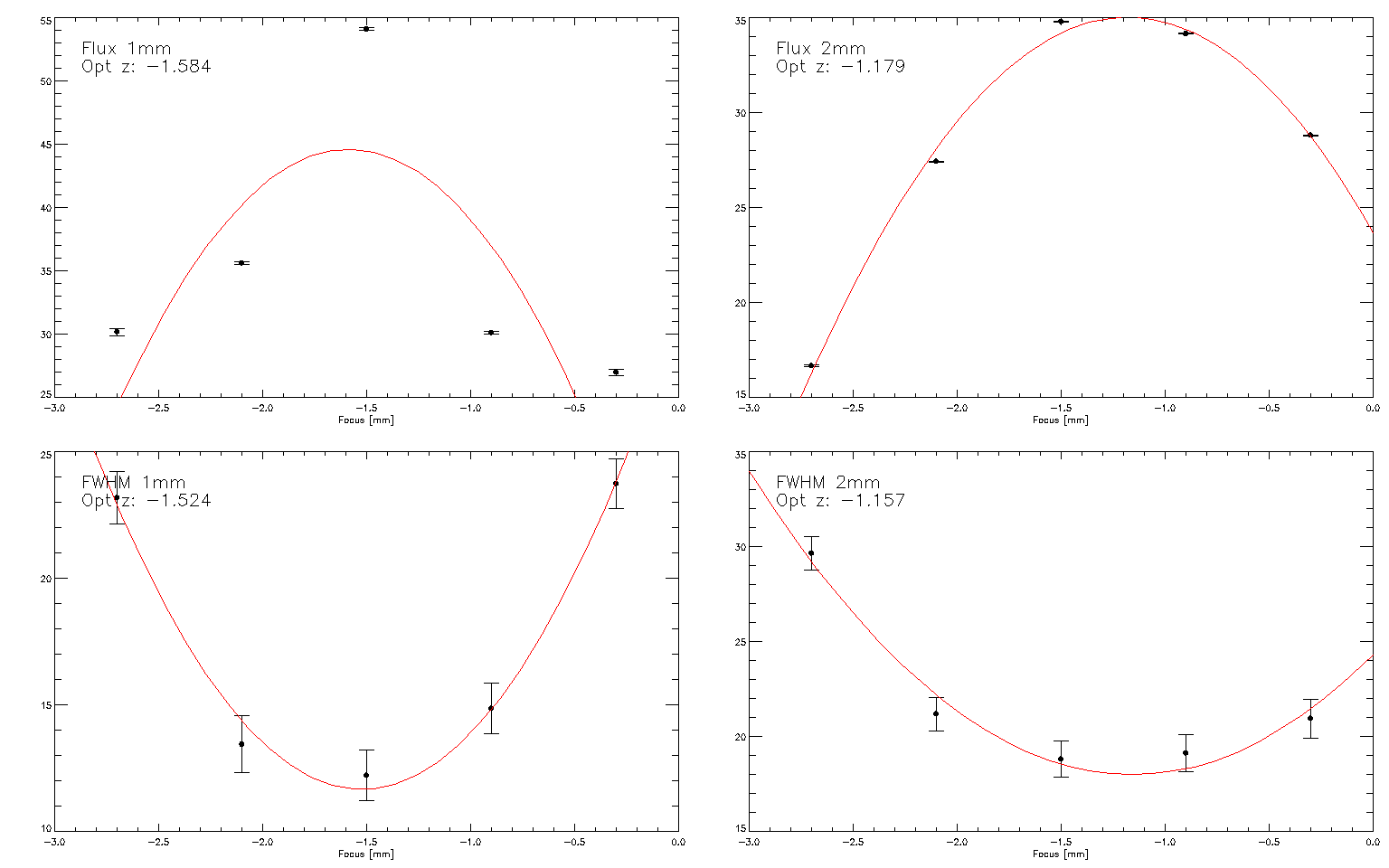
- We then derived a first OTF geometry to compute kid offsets. Then, choosing kid 494 as the reference detector (like in the previous run), we could derive the Nasmyth offsets required to center the planet on this reference kid, and redo a geometry.
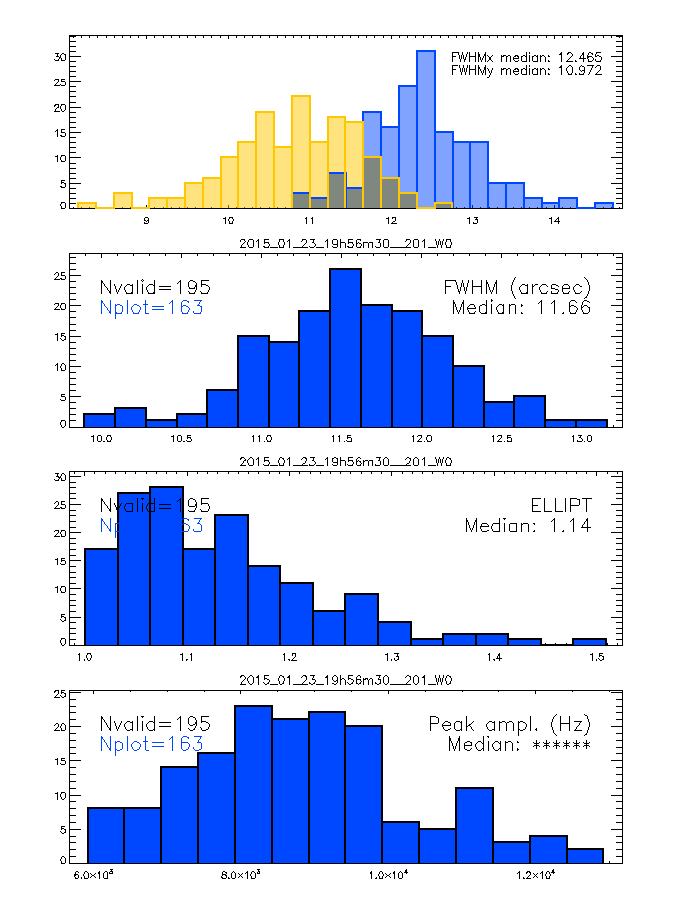
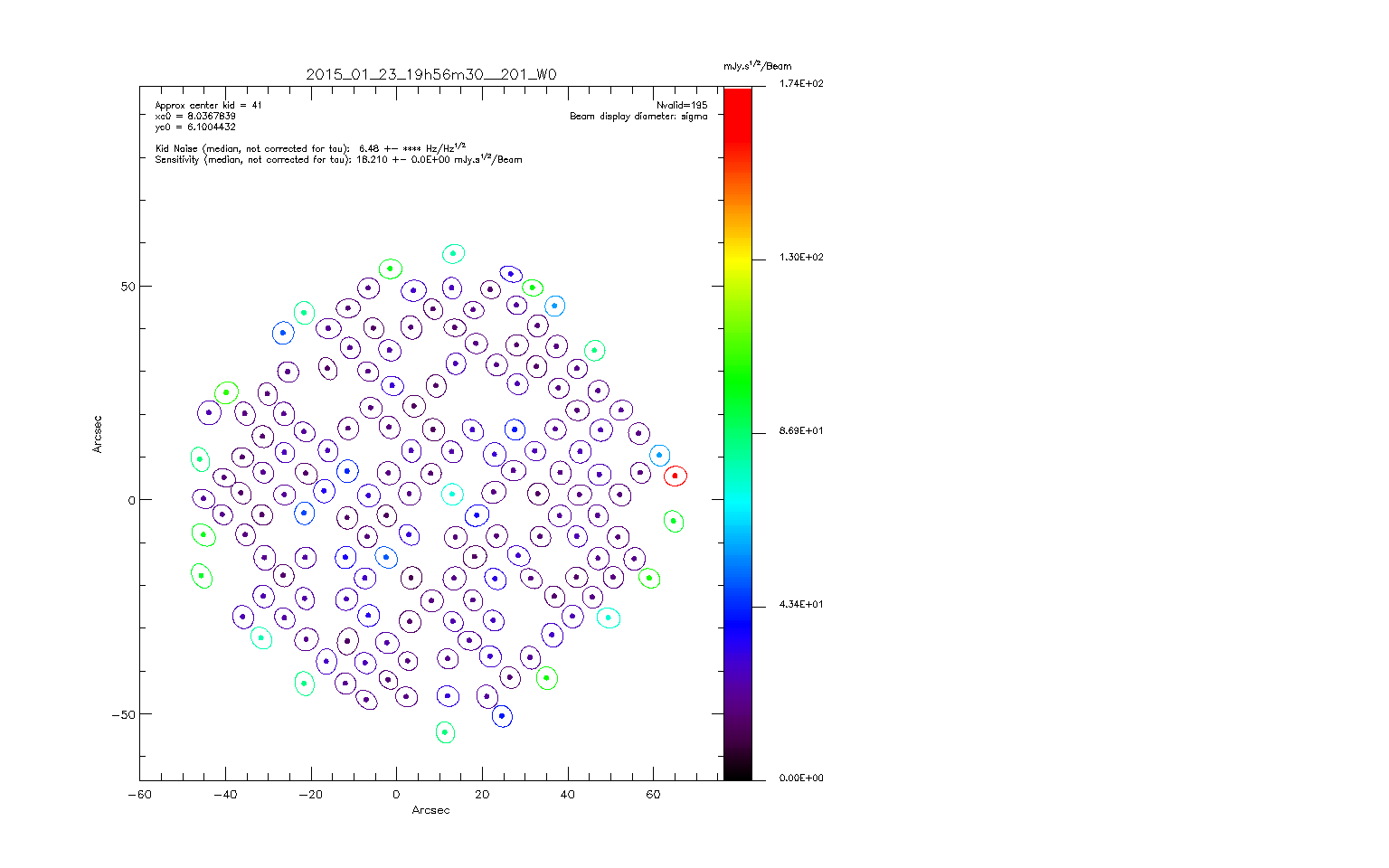
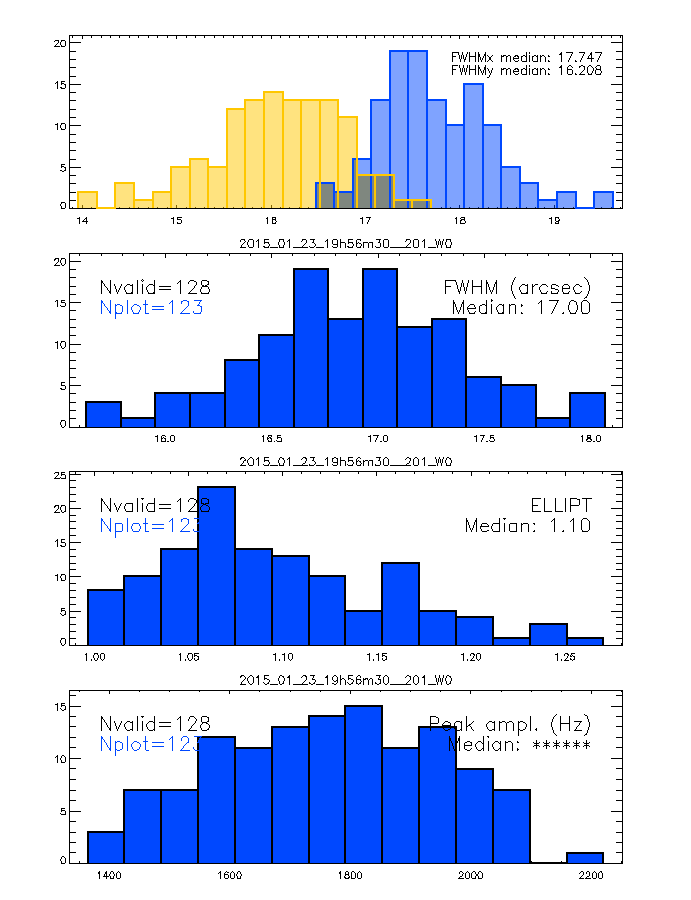
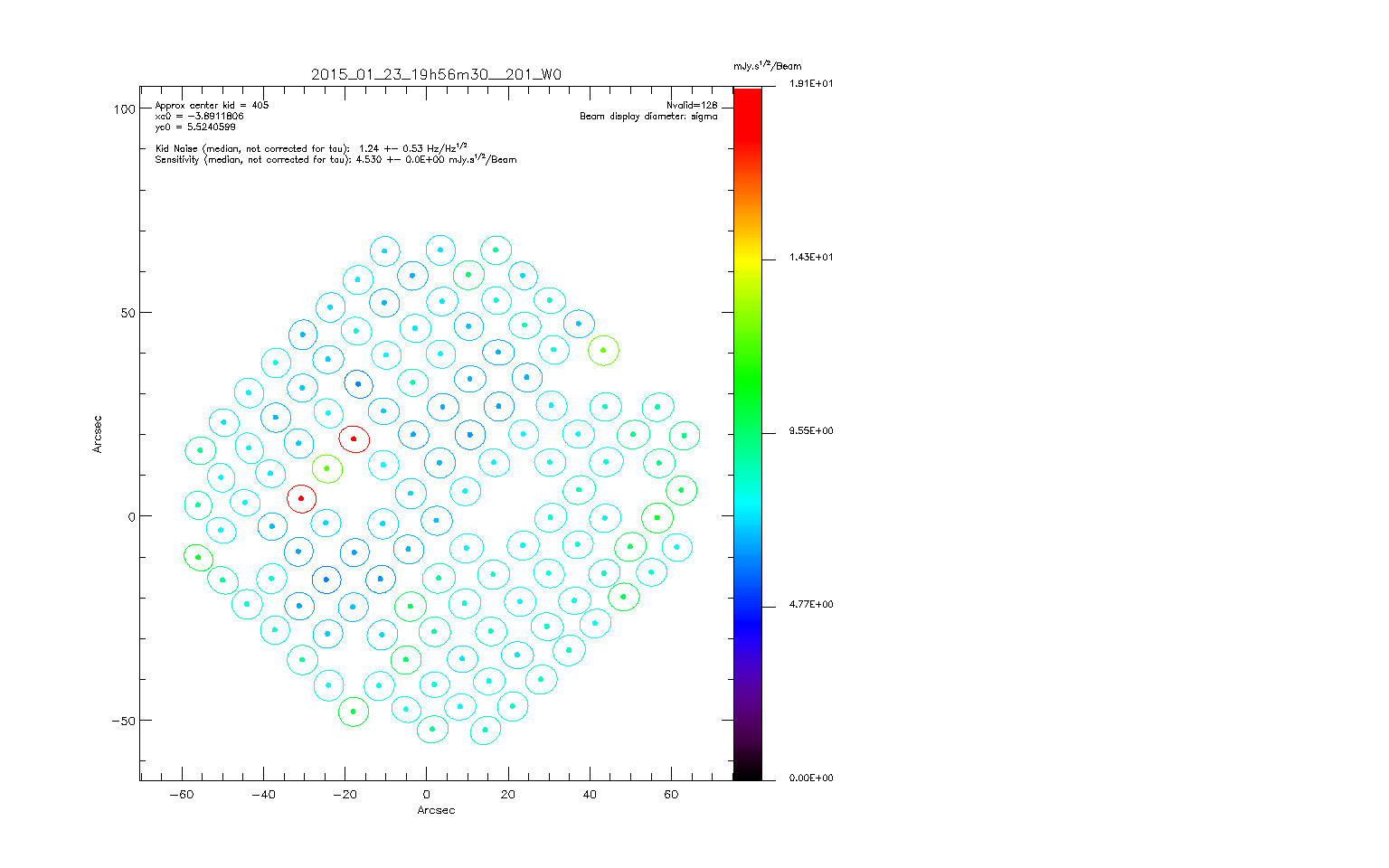
- We could check on a bright quasar that we were indeed centered and that our reduction scripts were still ok.
- We also did two skydips that went fine as far as acquisition is concerned. We'll look at them in detail tomorrow.
January 24th 2015
We observe from 9:00UT to 13:00pm. The opacity is 0.1-0.2, the wind is strong close to the telescope limit. We installed the polarisation facilities choosing to dedicate the observations to polarisation. Few warnings:
1) Sincronisation of nikels is very slow.
2) Sincronisation between nikels and mppsync seems not to work correctly. It takes a lot of time and the shift changes in time. [SOLVED: needed to put code horloge = 2 in the config file (run12.txt)]
3) Need to cut at least 2x2cmm the aluminium plate of the noise in order to be able to plug the canon connector on pol modulator.
4) Tuning procedure: From a tuning to an other the bad pixels could increase (o decrease) a lot, especially for the 1mm channel. [SOLVED]
5) Tuning procedure: even without "tuning auto" a tuning can be sent.....why? [SOLVED: Need to switch off autotuning and put 0 on the 'IP' field of the Controle window, which btw is now on MiniMac 2 together with all the other 'instruments']
Sun, January 25th 2015
We observed from 9:00UT to 13:00pm, but the wind is too strong so we stopped observation several times. We performed few pointing and one off_geometry on Venus and on DR21OH, 1 skydip. The skydip seems to work well. Here and example (with TAU 225GHz 0.24).
[Do we know the scaling relation between the opacity from the NIKA skydip at 1mm with its large bandpass and the taumeter value at 225GHz with its narrow bandpass of only 500MHz ? (CK)]
[From my calculation, the scaling relation between tau NIKA1mm and IRAM tau225 changes versus mmwv. Considering a measured tau1mm=0.29 from skydips, the scaling relation with tau225 (tau225/tau1mm) is about 0.65 (AC)]

Mon, January 26th 2015
Some observations carried out overnight, starting at 4am as the wind was too strong before. A few 'polarization-mode' maps (including with the prism), plus 'high resolution geometry' of the focal plane and the observation for the project that gave problems during the previous open pool due to the tunings in the 'single-stripe' scans.
In the morning, just a little bit tired after the night's work, Nicolas and Andrea leave, being replaced by Laurence and Barbara. A calm day (no hours for NIKA until tomorrow after the maintenance). Barbara and Laurence start to dive themselves into the pipeline, Martino makes the final adjustments on the different machines for the acquisition and the software updates. In the evening, everything seems to be fine and to work smoothly so we 'freeze' the configuration and wait for tomorrow to start.
Tue, January 27th 2015
Maintenance ongoing. As soon as we have access to the NIKA cryostat will check the measurements for the re-positioning of the Mppsync connector on the rotating wheel.
14h45 UT: After a moment of fear for the alignment, we are now all set and ready to observe....
Wed, January 28th 2015
Yesterday we observed in the afternoon, then the tau started to increase (>0.4) so mainly a few 'technical' scans (skydip, otfgeom..). The telescope is now stopped due to wind since 3am... And the weather forecast is not very promising for the coming days. Let's cross our fingers...
As far as the software is concerned: tunings work very well even with 'attente' 15 and 'moyenne' 10. All instruments survived the night without problems. The only issue left is linked to the elvin server and its communication with the other components: nikaelvin sometimes sees a delay of up to 10 s in the arrival of information, which translates in some missing blocks in the data, which become unreadable for the rta analysis and for nk_filing. Probably the data should be recoverable from the 'intermediate file'. We'll try to further investigate the issue...
Observation started again at noon. Tau not very good (done a skydip). Integrating the projects of N. Billot and of A. Traficante. Now, tau has improved and we catch the occasion to integrate on MACS0717. It's a good moment:
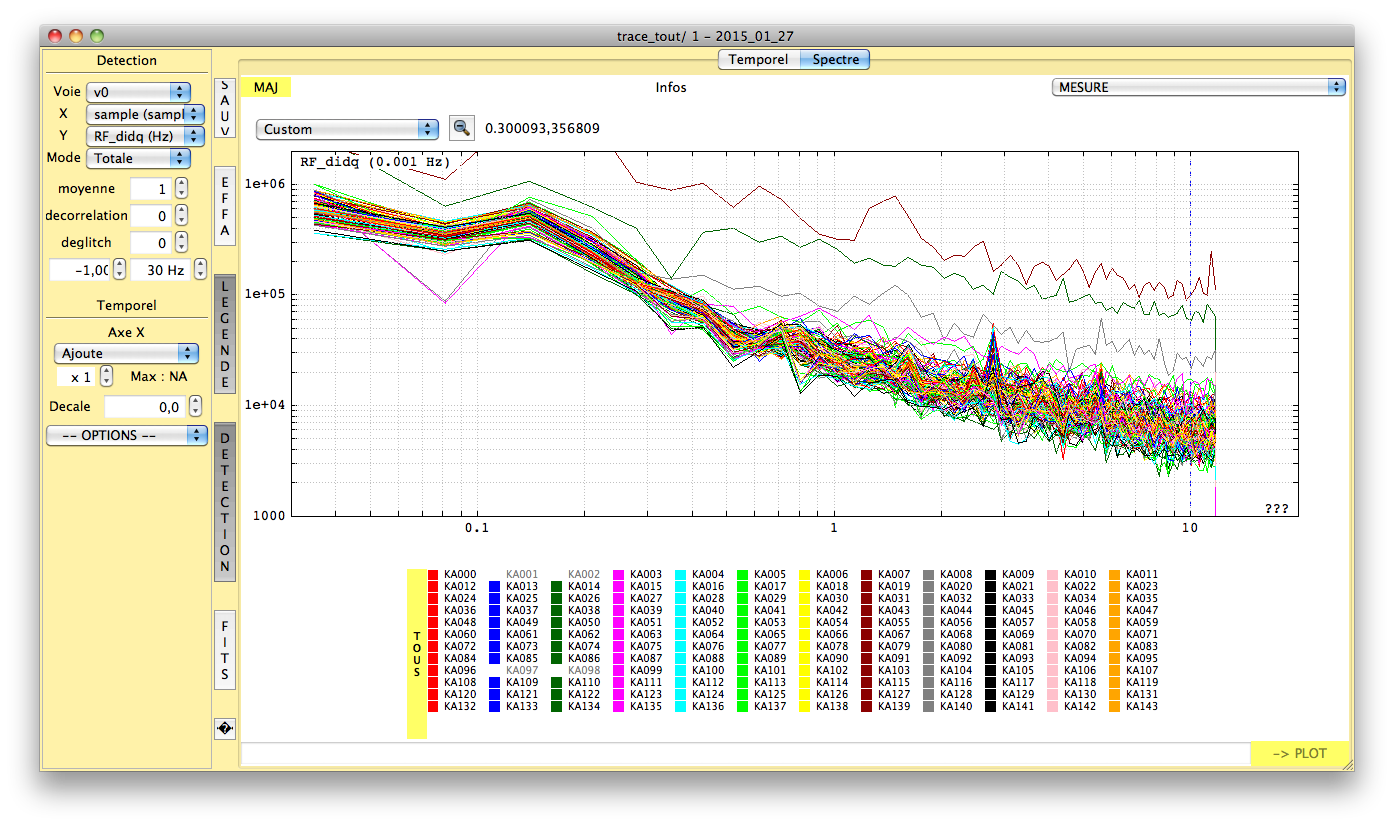
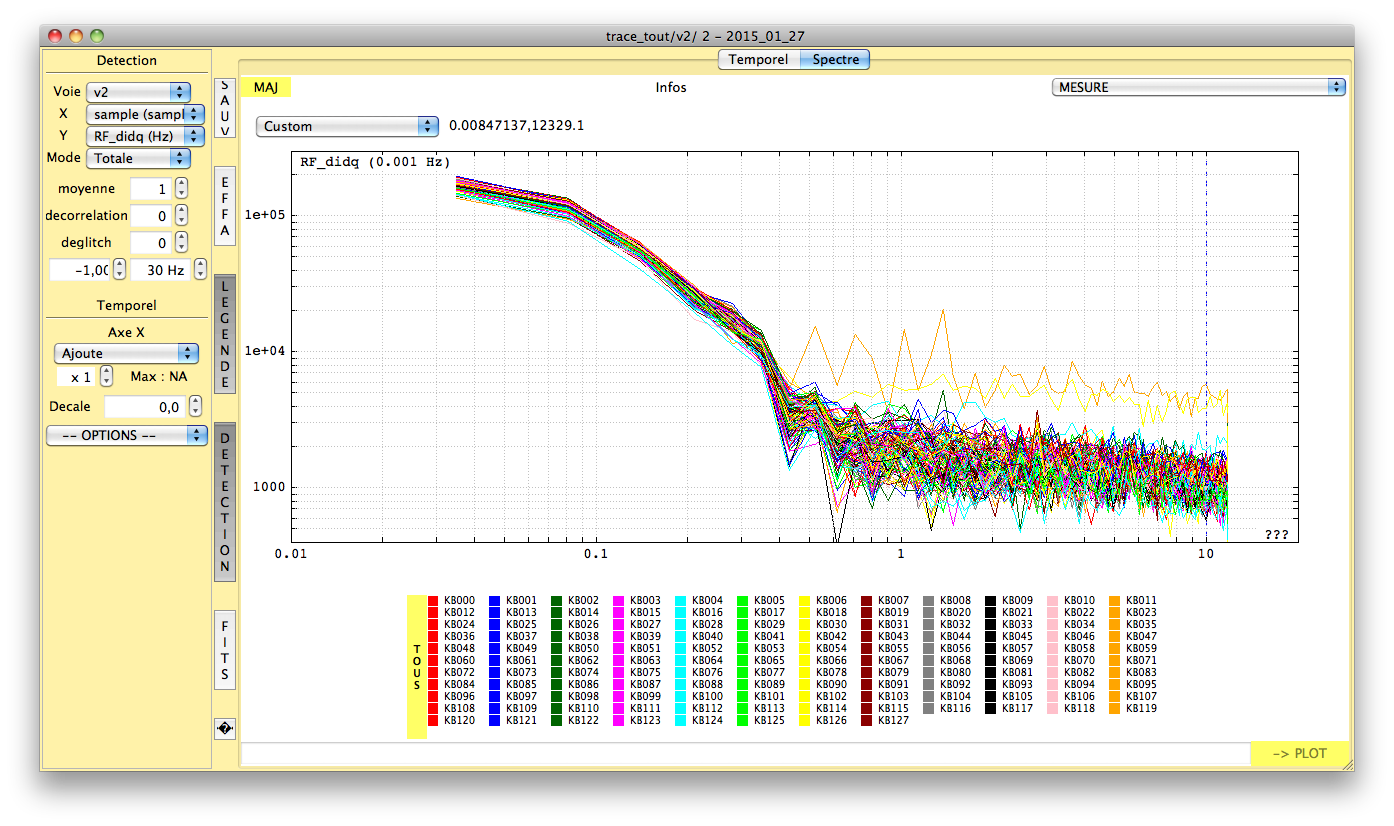
We have to make the most of it, as the weather forecast is really not promising at all.. ![]()
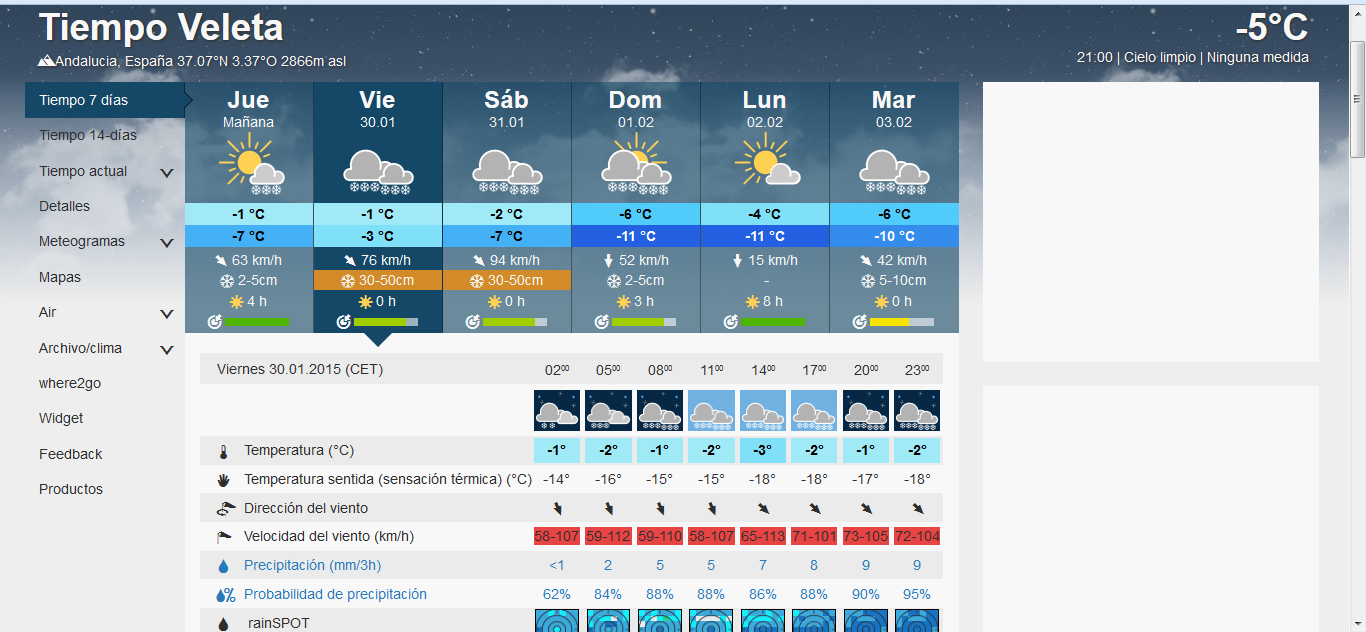
Thu, January 29th 2015
Observation all night long, and ongoing still now (17h). Yet, tau always pretty high (almost constantly above 0.3, now above 0.4). Testing now some scans at 68Hz as the observing conditions are in any case way too poor to make science. The wind is starting to rise, I guess it will not be long before we stop..
Fri, January 30th 2015
Stopped all day long... now snow but plenty of fog, wind, ice...
Sat, January 31th 2015
As above... Really bad weather. The most thrilling moment of the day was the refill of the nitrogen trap. That says a lot.
Sun, February 1st 2015
The sky is clear! Actually, the tau is super-low... But, everything is completely icy and there is still too much wind to move the antenna. It should get better as the hours go by, we all really hope so!
Waiting for the ice to melt. As these pictures show, it might take a few minutes more...
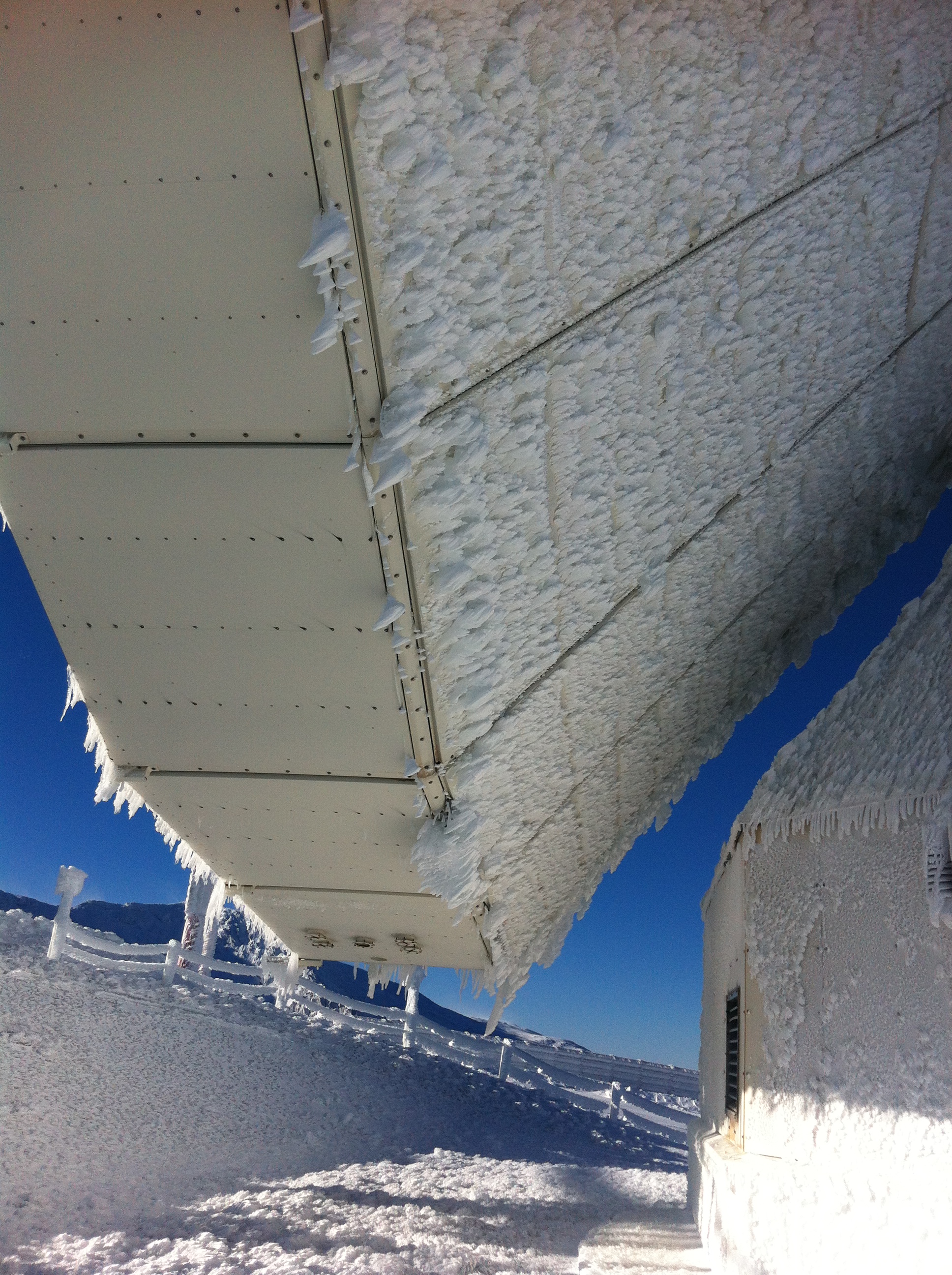
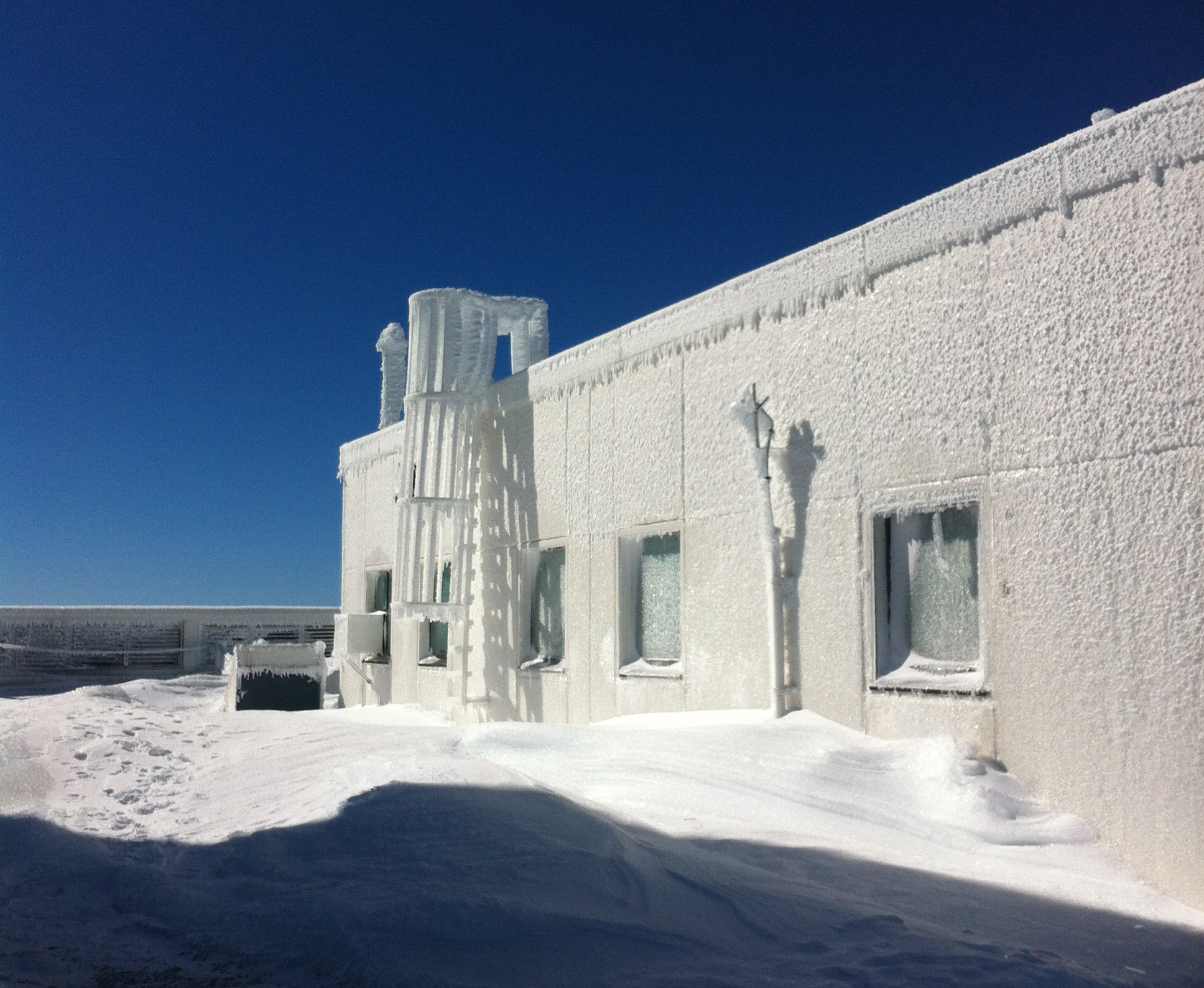

Update: no way!!! We are stopped, with tau stable at 0.1 and very little wind: probably toooooo much ice on the antenna, even just trying to increase the elevation causes an alarm for the excessive current needed. And in any case, the very few data we took gave very bizarre results, with beams large and distorted. Maybe still a little ice on the secondary. Or, more likely as the secondary was checked and looked ok, the weight of the ice is deforming the antenna! [CK: Probably the de-icing changes the thermal structure of the antenna, distorting the surface, and hence the beam. MC: yes, I agree, and we noticed it when we restarted observations. Yet, in this case, the problem was realy pathological, and a closer look to the secondary mirror confirmed that there was still quite a lot of ice. Below a few more details!] Now stopped, and though we are putting the maximum power on the de-icing, it's not likely to be enough before the sun comes back tomorrow. Right now -13°C outside...
So we wait...
Late in the evening, after more de-icing, we try again: a bit better but not much. Frederic checks again the secondary: a lot of ice still there, and a large block that might fall! We have to stop for the night, even with the de-icing we can't get rid of it...
Mon, February 2nd 2015
A (timid) sun in the morning (clearly, all the clouds are to the east..) helps with getting the telescope rid of the ice. At around 11 we start observing: not so good data, still big temperature differentials (up to 6 degrees) in different parts of the antenna because of the deicing, so focus and beam distorted. Everything seems to improve over time... Just as the tau increases. By the time we are kind of ok, tau goes above 0.4, and we end up in the fog in the afternoon. Stopped again. Make a few tests with a couple of Lissajous scans with the window in front of the cryostat. Then stopped completely
With the window in front of the cryostat the resonances offsets wrt the param run10.txt are -450 and -980kHz respectively. So still a bit lower than last run (roughly 100kHz lower).
Now (21:30) light snow and wind once again. Difficult to envisage observations before the maintenance, sadly.
Tue, February 3rd 2015
Martino left, I (Alessandro) arrived. Remi still here, hoping ...
Nothing happened today. Problems with sync during maintenance. Already seen it, who know what is circulating on the network ...
We connected the wave-plate motor and made it turn. And fixed again connection problems with the cryostat pumps stage. That's it.
Tonight (20h) everything quiet. The telescope still has ice on M2 and supports. Victor turned it to the Sun for the whole afternoon but now the clouds came up again. Wind is low. We hope for tonight. Forecast is improving since Thu.
Wed, February 4th 2015
Still nothing happening. Snow storm.
Thu, February 5th 2015
In the morning we see the Moon. But very windy, very cold (-16C). De-icing is at max power. Let see, the forecast is changing. The KID are hungry of good mm photons. In the afternoon Victor turned the antenna to the Sun but the wind is peaking at 17m/s and not possible to step up and clean. 16h40, we wait.
LN2 trap filled (yes !).
Prepared a check list for Andrea, Nicolas and the others unmounting NIKA.
Playing with the NIKA2 10-meters N-cable. I have verified that the losses are only 1dB higher for this long/big cable compared to the 2-meters long SMA cables we are using on NIKA.
Fri, February 6th 2015
Really not lucky. Last night Enrique went to clean M2. But a block of ice remains attaches on the M1 rim preventing from moving the antenna in elevation (risk to damage M1). This morning the antenna is looking the Sun, the de-icing at full power. We wait to start. But at least wind is low, sky is clear, forecast is encouraging.
18h15. The block of ice is stronger than expected. Still there, and the Sun is going down. We're on for a second tau=0.1 night without being able to move the dish. Among possible solutions: flying drone carrying a heater, a sound waves gun, a laser, a parabolic mirror focussing the Sun onto the antenna, tennis balls, liquid nitrogen bombs, microwaves gun, a shacking Lissajous hitting the ground ...
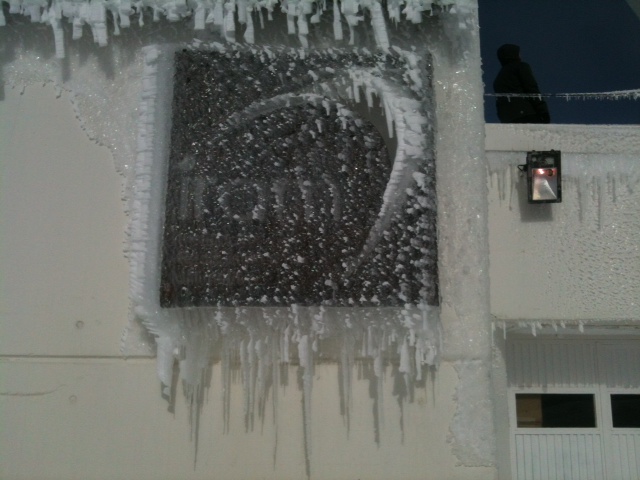
22h. To have some fun I estimated the size of the ice block at the top. Around 20cm width, but Enrique says it is very long (he has seen it from the platform last night !). This is based to the fact that the outer ring of panels is made by 76 panels themselves. So the width of the panel is 1.2m roughly. Then the ice is 1/6 roughly of the panel width. The second (looking at M1 from the front, on the left) is larger in width (may be 0.6-0.8m) but small in The third one is the smallest and it fell !!! Yes.
DECISION: go to bed.
Sat, February 7th 2015
8h. The ice is still there unfortunately. Sky is clear, Sun is rising. Victor turns the antenna to the Sun (toward Pico Veleta). Let see if it melts.
11h20. Surprise ! It seems free now. We turn the antenna to look better.
11h45. Starting ! Seems OK. Tuning, noise, filing etc. 12h. Not OK at 1mm. very high noise cables seem ok. I don't understand ... 2mm perfect
Observing for 30 min in vary bad weather and the 1mm f..d up.
14h. We go to the cabin. Try switching off the MMR3 first. Then changing the cables. No effect Reeboot the LO of the 1mm solved the problem !
15h. NOW NOISE OK ON 1mm
But still bad weather unfortunately
17h. Tau very variable, peaking at 0.7. Integrating on project 200-14 to hope seeing something at 2mm. High elevation.
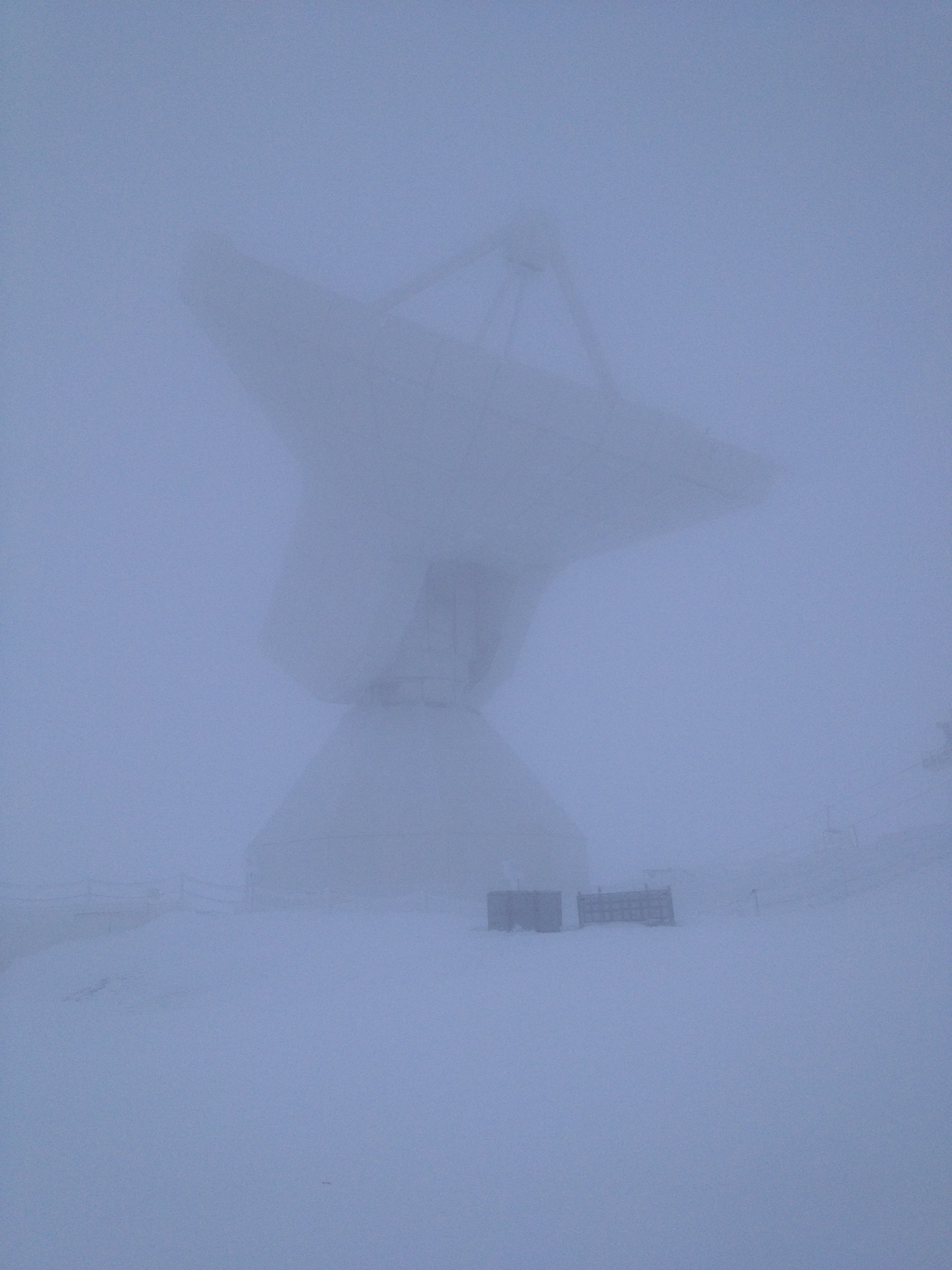
21h. Stopping again, snowing.
Sun, February 8th 2015
3h. Starting/stopping. Snowing, just a few scans.
8h30. Good weather, observations ongoing. Arrays are OK, tuning is working very well so far. Can even close the vertex and opening again without losing the resonances.
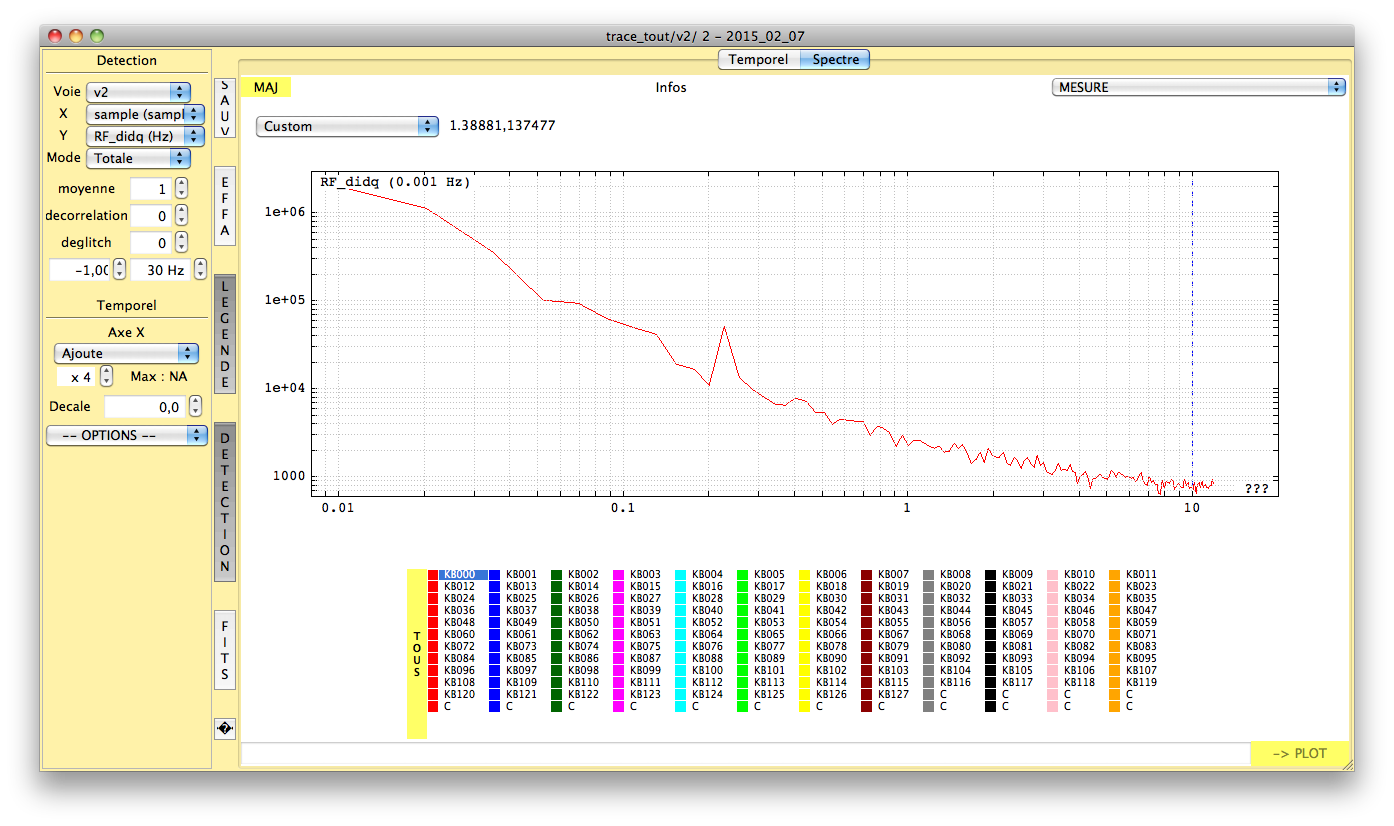
In the figure, we see a clear "noise line" at around 0.2Hz during a Lissajous scan (project 227-14). This could be a problem ? Does it really match with the Lissajous period ? To be checked.
WITH THE TAUMETER SHOWING TAU=0.2, AND AT 40DEG ELEVATION, -300kHz and -600kHz wrt param file (from run 8) at 2mm and 1mm respectively.
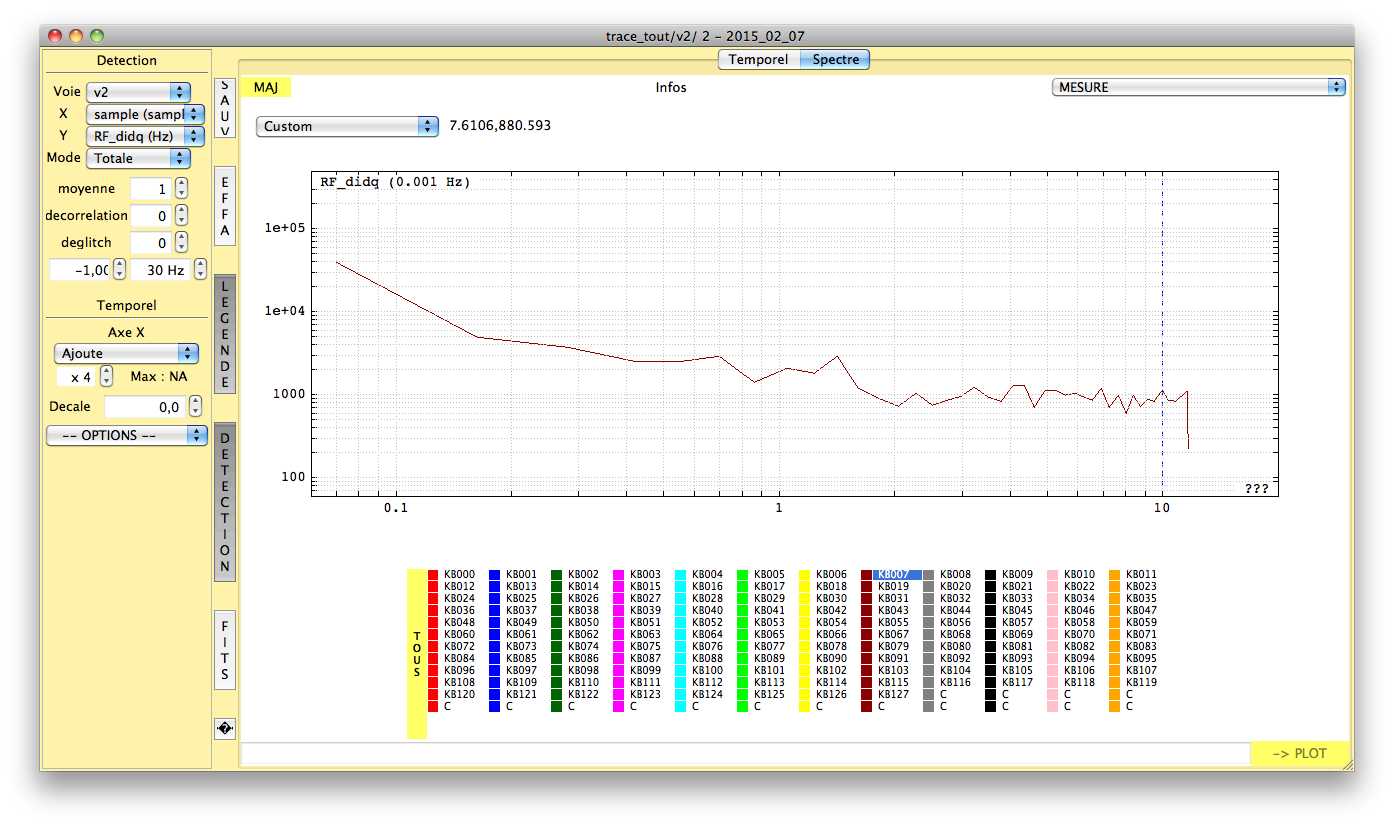 Figure. Noise in best conditions so far. Really nice, but it lasted 10 minutes !
Figure. Noise in best conditions so far. Really nice, but it lasted 10 minutes !
BEST CONDITIONS SO FAR, AT 35DEG ELEVATION, -275kHz and -520kHz wrt param file (from run 8) at 2mm and 1mm respectively.
But clouds again from nowhere.
17h30. Start again.
